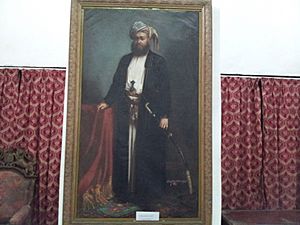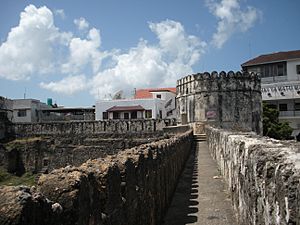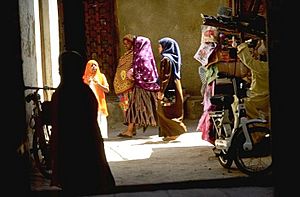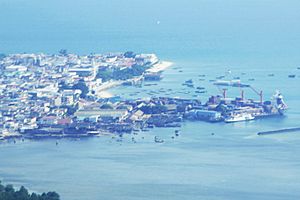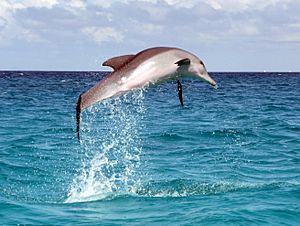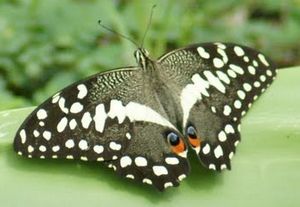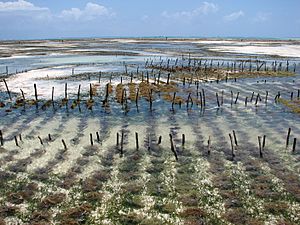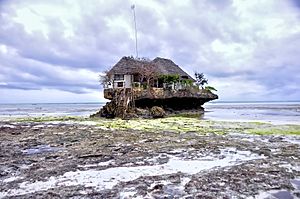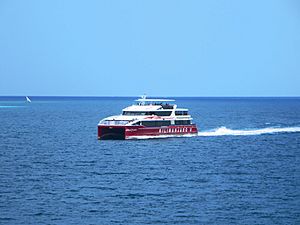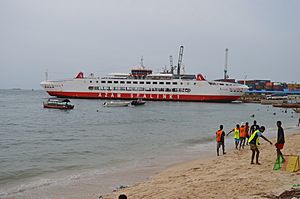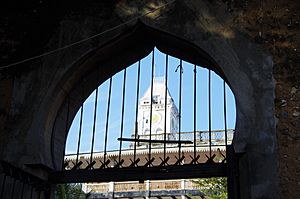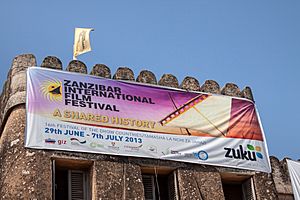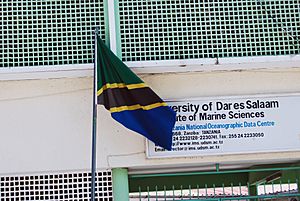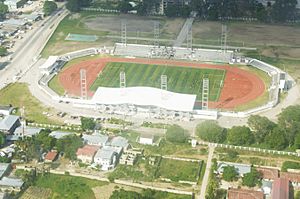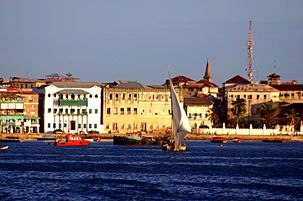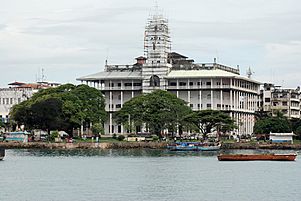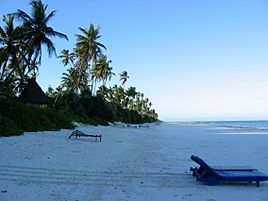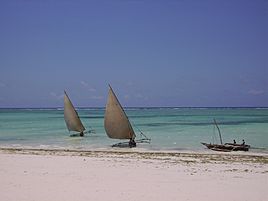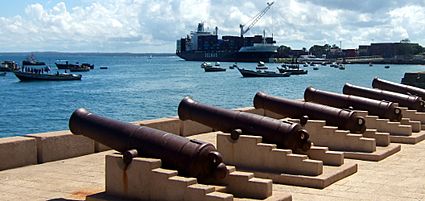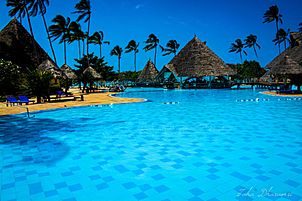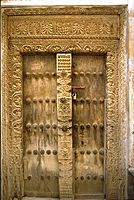Zanzibar facts for kids
Quick facts for kids
Zanzibar
|
|||
|---|---|---|---|
|
Semi-autonomous region of Tanzania
|
|||
|
|||
| Anthem: Mungu ametubarikia (Swahili) "God has blessed us" |
|||
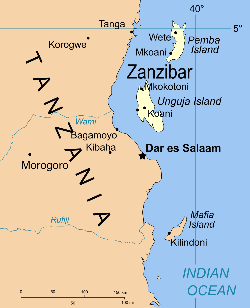
Location of Zanzibar within Tanzania
|
|||
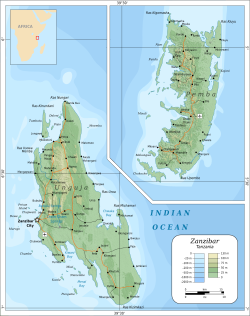
The major islands of Unguja and Pemba in the Indian Ocean
|
|||
| Capital | Zanzibar City | ||
| Official languages | |||
| Ethnic groups | |||
| Religion |
|
||
| Demonym(s) | Zanzibari | ||
| Government | Federacy | ||
| Hussein Mwinyi | |||
|
• First Vice President
|
Othman Masoud Sharif | ||
|
• Second Vice President
|
Hemed Suleiman Abdalla | ||
| Legislature | House of Representatives | ||
| Area | |||
|
• Total
|
2,462 km2 (951 sq mi) | ||
| Population | |||
|
• 2022 census
|
1,889,773 | ||
|
• Density
|
768.2/km2 (1,989.6/sq mi) | ||
| GDP (nominal) | 2020 estimate | ||
|
• Total
|
$3.75 billion | ||
|
• Per capita
|
$2,500 | ||
| HDI (2020) | 0.720 high |
||
| Currency | Tanzanian shilling (TZS) | ||
| Time zone | UTC+3 (EAT) | ||
|
• Summer (DST)
|
UTC+3 | ||
| Driving side | left | ||
| Calling code | +255 | ||
| Internet TLD | .tz | ||
Zanzibar is a special semi-autonomous region that is part of Tanzania. It joined with Tanganyika in 1964 to form the United Republic of Tanzania. Zanzibar is a group of islands in the Indian Ocean. It is about 25 to 50 kilometers (15 to 30 miles) off the coast of mainland Africa.
The region includes many small islands and two large ones. These are Unguja (often called Zanzibar) and Pemba Island. The capital city is Zanzibar City, which is on Unguja island. Its old town, Stone Town, is a World Heritage Site. This means it is a very important place to protect.
Zanzibar's main industries are spices, raffia, and tourism. The islands are famous for growing cloves, nutmeg, cinnamon, and black pepper. Because of this, Zanzibar and nearby Mafia Island are sometimes called the "Spice Islands." Tourism has grown a lot, from 19,000 visitors in 1985 to 376,000 in 2016. You can reach the islands by five ports or by the Abeid Amani Karume International Airport.
Zanzibar's ocean environment is vital for fishing and growing seaweed. It also has important areas where fish babies grow, helping fish populations in the Indian Ocean. On land, Zanzibar is home to unique animals like the Zanzibar red colobus monkey and the Zanzibar servaline genet. Sadly, the Zanzibar leopard is now very rare or extinct. Growing tourism and fishing, along with rising sea levels from climate change, are causing environmental worries.
Contents
History of Zanzibar
Zanzibar has a long and interesting history. People have lived here for at least 20,000 years.
Early Settlements and Trade
Around 1,000 AD, Bantu-speaking people settled in Zanzibar. They were farmers and fishers. Early findings show they built timber houses. They also traded with people from far away. By the 10th century, Zanzibar was a key trading town.
Merchants from Persia, India, and Arabia came to Zanzibar. They bought East African goods like gold and ivory. They then shipped these goods to Asia. African traders also came to the coast to trade for items like Indian cloth. This mix of cultures helped create the Swahili culture. The Swahili language also developed, borrowing words from Arabic.
Portuguese Influence
In 1498, the European explorer Vasco da Gama visited Zanzibar. This marked the start of European involvement. By 1504, Zanzibar became part of the Portuguese Empire. The Portuguese did not control the island very closely at first. Local leaders managed things.
However, after a rebellion in Mombasa, Portugal built a fort on Pemba Island around 1635. This showed they wanted more control.
The Sultanate Era
In 1698, Zanzibar came under the rule of the Sultanate of Oman. Local leaders invited Omani princes to settle there. In 1832 or 1840, Said bin Sultan, Sultan of Muscat and Oman moved his capital from Oman to Stone Town.
After Said's death in 1856, his sons divided his lands. Majid bin Said of Zanzibar became the first Sultan of Zanzibar. The sultans of Zanzibar controlled a large part of the East African coast.

The sultans created a strong economy based on trade and cash crops. Ivory was a big trade item. Zanzibar became famous for its cloves and other spices. Plantations were set up to grow them. Traders from India also came to live on the islands.
During Sultan Majid's rule, Zanzibar became a major center for the slave trade in East Africa. Many enslaved people were brought through Zanzibar City. One famous slave trader was Tippu Tip. He led large groups into Africa to capture people. He then sold them in Zanzibar's slave market.
Later sultans, like Barghash bin Said of Zanzibar, were pressured by the British to end the slave trade. Barghash greatly improved Zanzibar's buildings and services.
British Protectorate
The British Empire eventually gained control over Zanzibar. A big reason for this was the British effort to stop the slave trade. In 1822, Britain signed a treaty with Sultan Said to limit slave transport.
Britain kept pushing for the end of slavery. In 1873, Sultan Barghash signed a treaty that stopped the slave trade in Zanzibar. It also closed all slave markets.
In 1890, Zanzibar became a British protectorate. This meant Britain protected Zanzibar, but the Sultan still ruled. British officials advised the Sultan.
A short but famous war happened in 1896. Sultan Khalid bin Barghash of Zanzibar took power without British approval. British ships attacked his palace. The fighting lasted only 38 minutes, making it the shortest war in history.
Revolution and Union with Tanzania
On December 10, 1963, Zanzibar became fully independent from Britain. It was a monarchy with the Sultan as its leader.
However, on January 12, 1964, a revolution took place. Sultan Jamshid bin Abdullah of Zanzibar was removed from power. He went into exile. The Sultanate was replaced by the People's Republic of Zanzibar. This new government was socialist. During the revolution, many people were killed, mostly Arabs and Indians. Many others fled the country.
In April 1964, Zanzibar joined with mainland Tanganyika. They formed the United Republic of Tanganyika and Zanzibar. Soon after, they renamed it Tanzania. Zanzibar remains an autonomous region within Tanzania today.
People of Zanzibar
The population of Zanzibar was 1,889,773 in 2022. Most people, about two-thirds, live on Unguja island. Zanzibar City is the largest city. Other towns on Unguja include Chaani and Nungwi. Most people outside these towns live in small villages. They work in farming or fishing.
The population of Pemba Island was 362,166. The largest town there is Chake-Chake.
Ethnic Groups and Origins
Zanzibar's people come from many different backgrounds. The first permanent residents were the ancestors of the Hadimu and Tumbatu. They arrived from mainland Africa around 1000 AD.
Today, most Zanzibaris are ethnic Swahili. There are also people of Arab, Persian, Somali, and Indian descent.
Languages Spoken
The main language in Zanzibar is Swahili (Kiswahili). This language is widely spoken across East Africa. Swahili is an official language of Tanzania. Many people also speak Arabic and English.
The Swahili dialect spoken in Zanzibar is called Kiunguja. It has many Arabic words. Kiunguja is considered the standard form of Swahili.
Arabic is also used in Zanzibar. However, it is not as widely spoken as Swahili today. Standard Arabic is important for religious reasons, especially for Muslims.
Religions in Zanzibar
Most people in Zanzibar are Muslim, making up about 99% of the population. There is a small Christian minority. Other religious groups include Hindus, Jains, and Sikhs.
There are many places of worship in Zanzibar City. These include Muslim mosques, Christian churches, and Hindu temples.
Government and Politics
Zanzibar has its own government. It is called the Revolutionary Government of Zanzibar. This government includes the Revolutionary Council and the House of Representatives.
The House of Representatives has elected members. It also has members appointed by the President of Zanzibar. Some seats are set aside for women. Zanzibar is divided into five administrative regions.
Zanzibar has many political parties. The two most popular are the Chama Cha Mapinduzi (CCM) and the Civic United Front (CUF). These parties have sometimes had disagreements.
In 2010, voters approved a change to Zanzibar's constitution. This change allows rival parties to form governments together. This helps create more unity.
Geography of Zanzibar
Zanzibar is a group of islands in the Indian Ocean. It is located next to mainland Tanzania.
Unguja island is about 85 kilometers (53 miles) long and 39 kilometers (24 miles) wide. It has an area of 1,464 square kilometers (565 square miles). The island is mostly flat, with its highest point at 120 meters (390 feet). Unguja has beautiful sandy beaches and coral reefs. These reefs are full of marine life.
Pemba island is about 67 kilometers (42 miles) long and 23 kilometers (14 miles) wide. It has an area of 985 square kilometers (380 square miles). Pemba is also mostly flat.
Climate and Weather
Zanzibar has a tropical monsoon climate. This means it is warm all year round. Strong sea breezes often cool the summer heat.
There are two main rainy seasons. The first is in March, April, and May. The second is in November and December. The months in between get less rain.
| Climate data for Zanzibar City | |||||||||||||
|---|---|---|---|---|---|---|---|---|---|---|---|---|---|
| Month | Jan | Feb | Mar | Apr | May | Jun | Jul | Aug | Sep | Oct | Nov | Dec | Year |
| Mean daily maximum °C (°F) | 33.4 (92.1) |
34.1 (93.4) |
34.2 (93.6) |
31.7 (89.1) |
30.6 (87.1) |
30.0 (86.0) |
29.3 (84.7) |
29.8 (85.6) |
31.0 (87.8) |
31.7 (89.1) |
32.4 (90.3) |
33.0 (91.4) |
31.8 (89.2) |
| Daily mean °C (°F) | 28.5 (83.3) |
28.8 (83.8) |
28.8 (83.8) |
27.5 (81.5) |
26.6 (79.9) |
25.9 (78.6) |
25.2 (77.4) |
25.1 (77.2) |
25.6 (78.1) |
26.1 (79.0) |
27.1 (80.8) |
28 (82) |
26.9 (80.4) |
| Mean daily minimum °C (°F) | 23.6 (74.5) |
23.6 (74.5) |
23.5 (74.3) |
23.4 (74.1) |
22.7 (72.9) |
21.8 (71.2) |
21.2 (70.2) |
20.5 (68.9) |
20.2 (68.4) |
20.6 (69.1) |
21.9 (71.4) |
23.1 (73.6) |
22.2 (72.0) |
| Average precipitation mm (inches) | 69 (2.7) |
65 (2.6) |
152 (6.0) |
357 (14.1) |
262 (10.3) |
59 (2.3) |
45 (1.8) |
44 (1.7) |
51 (2.0) |
88 (3.5) |
177 (7.0) |
143 (5.6) |
1,512 (59.5) |
| Source: Climate-Data.org | |||||||||||||
Wildlife of Zanzibar
Animals on Unguja Island
Unguja, Zanzibar's main island, has animals that are similar to those on mainland Africa. This is because it was connected to the mainland during the last Ice Age.
One unique animal is the Zanzibar red colobus monkey. It is one of Africa's rarest primates, with only about 1,500 left. These monkeys have lived on the island for at least 1,000 years. They have different fur, calls, and eating habits than other colobus monkeys. You can often see them near Jozani Forest.
Other rare native animals include the Zanzibar servaline genet. The Zanzibar leopard is now very rare or possibly extinct. There are no large wild animals on Unguja. You can find monkeys, small antelopes, and civets in forested areas. The island also has many different birds and butterflies.
Animals on Pemba Island
Pemba Island is separated from Unguja and the mainland by deep water. This means it has fewer types of animals. The island is home to the Pemba flying fox, a type of bat.
Economy and Industries
Zanzibar has been a trading hub for a very long time. Traders from Arabia, Persia, and India visited the islands as early as the 1st century. They used monsoon winds to sail to Zanzibar's safe harbor.
Cloves were brought to Zanzibar by Omani sultans in the 1800s. Zanzibar, especially Pemba Island, used to be the world's top clove producer. However, clove sales have dropped a lot since the 1970s. This is due to global market changes and competition.
Zanzibar exports spices, seaweed, and raffia. Fishing and making traditional dugout canoes are also important. Tourism brings in a lot of money from other countries.
The government has created a free port area. This helps with trade by allowing goods to be imported, exported, and stored easily. This also helps create new jobs.
Zanzibar's manufacturing is small. It mainly produces things like cigarettes and shoes for local use. The islands still import most of their basic needs, like fuel and manufactured goods.
There might be oil on Pemba Island. If found, this could greatly boost Zanzibar's economy. However, there are disagreements about how the money from oil would be shared with mainland Tanzania.
Tourism in Zanzibar
Tourism is the biggest money-maker for Zanzibar. It brings in about 25% of the islands' income. The government wants Zanzibar to be a top tourism spot in the Indian Ocean.
More tourists mean more impact on the environment. It also has mixed effects on local communities. While tourism brings money, it can also reduce access for locals to coastal resources.
Energy Sources
Zanzibar's energy comes from electricity, petroleum, and firewood. Coal and gas are rarely used.
Unguja island gets most of its electricity from mainland Tanzania. It comes through a 39-kilometer (24-mile) underwater cable. This cable started working in 2013. Pemba Island also has an underwater electrical link to the mainland since 2010. This has greatly improved electricity supply.
Most electricity is used by homes. Less than 20% is used by industries. Many rural and urban areas still use firewood, charcoal, and kerosene for cooking and lighting.
Zanzibar has faced major power outages in the past. These blackouts have hurt the economy, especially tourism.
Transportation
Roads and Public Transport
Zanzibar has about 1,600 kilometers (1,000 miles) of roads. Most of them are paved.
There is no government-owned public transportation. People use privately owned minibuses called "Daladalas." The name "Daladala" comes from the word "dollar." This is because a ride used to cost five shillings, which was like a dollar.
Stone Town is the main hub for Daladalas. They do not run on a fixed schedule. They leave when they are full. There are plans to start a government bus service. This would help reduce traffic and the environmental impact of tourism.
Sea Travel
There are five ports in Zanzibar. The main port in Malindi handles most of Zanzibar's trade. It has been rebuilt several times. A new passenger port is planned for Mpigaduri.
Air Travel
Zanzibar's main airport is Abeid Amani Karume International Airport. It can handle large passenger planes. Since 2013, it can serve up to 1.5 million passengers per year. Many airlines fly to Zanzibar.
Culture of Zanzibar
Zanzibar's most famous event is the Zanzibar International Film Festival (ZIFF). It is also known as the Festival of the Dhow Countries. This event happens every July. It shows the best arts from the Swahili Coast, including Zanzibar's favorite music, taarab.
Zanzibar is the birthplace of Freddie Mercury. He was the famous singer of the band Queen.
Important buildings in Stone Town include the Livingstone house and the House of Wonders. The town of Kidichi has the Hamamni Persian Baths. These were built by immigrants from Shiraz, Iran.
Zanzibar is also unique in East Africa for its long settlement houses. These are known as Michenzani flats. They were built in the 1970s to help with housing.
Media and Communication
In 1973, Zanzibar was the first place in sub-Saharan Africa to have color television. The local broadcaster is now called Zanzibar Broadcasting Corporation (ZBC).
Zanzibar has one AM radio station and 21 FM radio stations. Most mobile phone and internet companies from mainland Tanzania also operate in Zanzibar.
Education System
In 2000, Zanzibar had 207 government schools and 118 private schools. It has three accredited universities: Zanzibar University, the State University of Zanzibar (SUZA), and Sumait University.
SUZA is the only public university in Zanzibar. It was started in 1999.
Primary and secondary education in Zanzibar is a bit different from mainland Tanzania. In Zanzibar, three extra years of secondary education are compulsory and free. However, students in Zanzibar score lower on reading and math tests than those on the mainland.
Sports and Activities
Football is the most popular sport in Zanzibar. The Zanzibar Football Association manages it. Zanzibar is part of the Confederation of African Football (CAF). However, it is not a member of FIFA. This means the national team cannot enter major CAF or FIFA competitions.
Zanzibar's football clubs can play in the CAF Confederation Cup and the CAF Champions League. The national team plays in other tournaments like the FIFI Wild Cup.
Zanzibar also has its own Premier League for top football clubs. They also play in knockout competitions like the Zanzibari Cup.
Cricket used to be popular in Zanzibar. The island hosted teams from other countries in the 1950s and 1960s. The sport declined after the 1964 revolution. Efforts are now being made to bring cricket back.
Since 1992, judo has also been present in Zanzibar. The Zanzibar Judo Association is a member of the Tanzania Olympic Committee.
Notable People from Zanzibar
- Samia Suluhu Hassan, the current President of Tanzania.
- Said Salim Bakhresa, a very successful business person.
- Abdulrazak Gurnah, who won the Nobel Prize in Literature in 2021.
- Lubaina Himid, an artist who won the Turner Prize in 2017.
- Javed Jafferji, an award-winning photographer.
- Bi Kidude, a famous Taarab singer.
- Freddie Mercury, the lead singer of the rock band Queen.
- Siti binti Saad, a pioneering Taarab artist.
Images for kids
-
Cloves have played a significant role in Zanzibar's historic economy.
-
The red colobus of Zanzibar (Procolobus kirkii), taken at Jozani Forest
See also
 In Spanish: Zanzíbar para niños
In Spanish: Zanzíbar para niños




